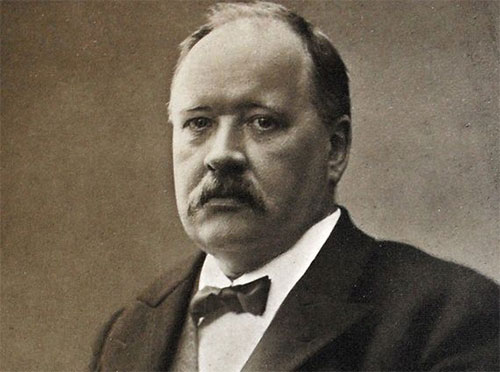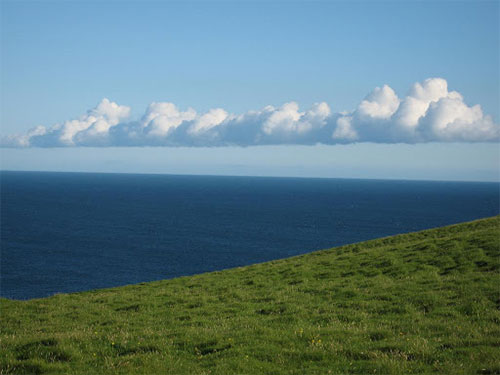Chemtrails exposed: The common roots of the New Manhattan Project and the theory of man-made global warming (1)
As Archimedes declared… “Eureka!”
As it turns out, both the New Manhattan Project and the theory of man-made global warming share many important, early historical roots. Both came from a group of Swedish scientists active during the late 1800s and early 1900s.

These scientists were members of something called the Stockholm Physics Society. The founder and main attraction of this group was a man by the name of Svante Arrhenius (1859-1927). Svante Arrhenius was the scientist who originally came up with the theory of man-made global warming and he did it during his time with the Stockholm Physics Society.
Arrhenius and the Stockholm Physics Society’s work pertaining to plasma physics, atomic physics, meteorology, atmospheric electricity, and weather modification also provide compelling links to today’s global weather modification project the author appropriately calls the New Manhattan Project.
This article is mostly based upon a biography of Svante Arrhenius by Elisabeth Crawford titled Arrhenius: From Ionic Theory to the Greenhouse Effect. Oddly enough, this book was published in 1996; the same year that large-scale domestic spraying operations began.
Svante Arrhenius
Svante Arrhenius was a Swedish scientist who was the first person to significantly assert and popularize the theory of man-made climate change.
Although Arrhenius is not very well known today, in his time he was considered Sweden’s most prominent scientist; receiving a slew of honorary doctorates from the most prestigious universities in Europe as well as a large heap of exclusive awards and medals including the 1903 Nobel prize for chemistry. He worked internationally and in multiple languages.
Arrhenius worked in his native Swedish as well as in the German, English, and French languages, with German being the most predominant. He often published in all four languages. Crawford notes that, “His closest working relationships were with members of the German, English, and, later, American scientific communities.” He was quite gregarious and had hundreds of scientist friends in Europe and North America.
Arrhenius was born on February 19, 1859 near the city of Uppsala, Sweden. His father was the agent for a noble family called the von Essens. Soon after his birth, his family moved into a house inside the city of Uppsala proper. This was where Arrhenius spent his childhood and youth.

Svante Arrhenius
Arrhenius was admitted to Uppsala University in 1876 where he concentrated on his studies of mathematics, physics, and chemistry. The University of Uppsala, founded in 1477, is Sweden’s oldest and Arrhenius’ father was an employee of the university.
In 1881, Arrhenius followed his professor Otto Petterson to the capital city of Stockholm to study at the new Stockholm Högskola for three years. The Stockholm Högskola had opened in 1878 as a private, non-degree-granting institution of higher learning oriented toward the sciences. These three years at the Högskola set Arrhenius’ work on the course he was to follow for the next decade.
In Stockholm, Arrhenius also studied at the Institute of Physics of the Swedish Academy of Sciences under Erik Edlund (1819-1888). Sweden’s Central Meteorological Office was located at the Institute of Physics and until the early 1870s, Arrhenius’ mentor, Edlund had been in charge of weather observations there.
Undoubtedly at the behest of Edlund, it was during his time at the Academy that Arrhenius made his first serious excursion into the atmospheric sciences and, even more pertinently, his first serious excursion into the field of atmospheric electricity with a paper on the topic of ball lightning published in the Academy proceedings.
Arrhenius began to move within a broad network of European scientists that was centered on the Committee on Electrolysis of the British Association for the Advancement of Science (BAAS). The BAAS was headed by the noted physicist Sir Oliver Lodge (1851-1940). Sir Oliver Lodge was the main European pioneer in the field of electrostatic precipitation and, as readers of this work already know, the field of electrostatic precipitation is central to the New Manhattan Project.
Arrhenius eventually established a lively academic discourse with Lodge. The two conversed mostly about early plasma physics. Although they didn’t call it that yet, plasma physics is another field with direct relevance to today’s New Manhattan Project mainly due to the fact that ionospheric plasmas are today being manipulated by ground-based antennas known as ionospheric heaters.
Although they were not fast friends, the famous scientist Max Planck (1858-1947) was also one of Arrhenius’ contemporaries.
Arrhenius was also involved in the field of early atomic physics. This is relevant to our investigation for the fact that today’s New Manhattan Project is an outgrowth of the original Manhattan Project; which was all about atomic physics.
Arrhenius later became a student of radioactivity in 1909 when he was taught by the famous, pioneering atomic physicist Ernest Rutherford (1871-1937) at the University of Manchester.
After studying abroad in Germany, Arrhenius returned to Sweden in 1891 to find that a new culture had swept the nation. This new, emergent culture appears to have been somewhat similar to that which emerged in America in the late 1960s. It was marked by individual introspection, communion with the natural world, and political progressivism.
This new culture was largely centered around a small elite in Stockholm which expressed itself through art, literature, and science. Social Darwinism played a central role in the philosophy of this new cultural movement. This progressive movement of the late 1800s in Sweden even had its own dialect known as ‘New Swedish.’
Also upon his return, Arrhenius became a teacher of physics at the Stockholm Högskola. In 1893 Arrhenius was joined at the Högskola by Vilhelm Bjerknes (1862-1951). The two went on to become good friends and colleagues. The presence of Vilhelm Bjerknes is significant to our investigation because he went on to identify the basic equations of atmospheric dynamics which eventually paved the way for today’s computerized atmospheric modeling.
Bjerknes had studied under Heinrich Hertz (1857-1894) at the University of Bonn. His doctoral dissertation was about experimental investigations of Hertzian waves. Hertz is the father of the study of electromagnetic energy, which plays a key role in the NMP. His generalized theorems of atmospheric circulation were based on analogies between hydrodynamic and electromagnetic forces.
The Swedish meteorological establishment had extensive ties to the Stockholm Högskola and Arrhenius. The first director of Sweden’s Central Meteorological Office, a man by the name of Robert Rubenson, was a professor of physics at the Högskola from 1878 to 1887. Another Central Meteorological Office meteorologist by the name of Nils Ekholm (1848-1923) became one of Arrhenius’ closest collaborators.
Cosmic physics and the Stockholm Physics Society
In the fall of 1891, Arrhenius initiated the Stockholm Physics Society as a forum for lectures and discussion pertaining to the latest advances in physics. In the context of this new Society, physics was defined broadly as comprising neighboring fields such as meteorology, geophysics, astrophysics, and physical chemistry.
The fortnightly meetings of this new Society were held at the Physics Institute of the Stockholm Högskola. A man by the name of Bernard Hasselberg was elected president, the aforementioned Otto Petterson became vice-president, and Arrhenius became secretary. This new Society was immediately well attended. The aforementioned Robert Rubenson and Nils Ekholm attended the meetings as well a third man associated with the Central Meteorological Office by the name of Hugo Hamburg. The Stockholm Physics Society was more like a social debating club rather than a serious scientific institution.
The largest number of lectures at this new Stockholm Physics Society meeting at the Stockholm Högskola concerned the physics of the Earth, the sea, and the atmosphere. This area of study was known as ‘cosmic physics.’ Early on, most of the lectures on cosmic physics were given by Arrhenius himself. Cosmic physics is of direct applicability to today’s New Manhattan Project because modification or control of the earth’s weather must take into consideration not only the physics of the atmosphere, but all environmental factors.

Although Arrhenius probably first heard of cosmic physics during his time studying abroad in Germany, where it had been institutionalized, the variety of cosmic physics practiced in Sweden in the late 1800s and early 1900s was substantially different than that which was practiced in Germany. The German cosmic physicists served as counterparts to the Swedish cosmic physicists.
This was not Arrhenius’ first work in the subject. Years earlier, in 1888, Arrhenius had studied atmospheric electricity; an aspect of cosmic physics. He analyzed measurements of atmospheric electricity as well as other meteorological data in order to understand the influence of ultraviolet light from the sun on the conductivity of the air. This was all in order to explain the movement of charged particles (ions) in the earth’s electric field and dispersion of electricity in the atmosphere. Arrhenius’ early in this subject has the New Manhattan Project written all over it.
At the Stockholm Physics Society, Arrhenius also reported on his continuing work in the area of atomic physics. Other members offered information on topics with relevance to the New Manhattan Project such as aeronautics.
The members of the Stockholm Physics Society shared not only a consuming interest in physics, but they also shared a political ideology. They were a product of their times in that they were politically progressive. Conversely, members of the progressive political parties of the time were also scientists. With the influence of these predominant political views surrounding him, Arrhenius became a progressive himself.
Crawford writes:
“While the passion for science was the primary bond between members of the society, they also shared progressive political opinions. Several of them – Nils Ekholm, Hugo Hamberg, Arvid Högbom – had been radicalized as students at Uppsala in the 1880s and one of them, Arvid Högbom, could claim to have been the first dues-paying member of the radical student association Verdandi, founded in 1882. The political circles in the capital with which they were most likely to sympathize were liberal reformist ones. The Liberals favored extending voting rights, limited at the time to about six percent of the adult population (women did not have the right to vote), and improving social welfare. In these and other issues, they often made common front with the Social Democrats. There were scientists among the supporters of both parties; in fact, the Social democratic leader, Hjalmar Branting, had worked as an astronomer before becoming engaged full-time in politics and political journalism. It was a new experience for Arrhenius to consort with colleagues whose political beliefs were translated into action. He had probably not given politics much thought before leaving Sweden. Although he never was much interested in politics, he nevertheless acquired the liberal reformist views that he would hold for the rest of his life.”
Crawford continues,
“The members of the Physics Society and the broader scientific circles in which Arrhenius moved shared a distinctive conception of the role of science in society. Having first-hand knowledge of the many ways in which science had improved living conditions – electric lights at home and in the streets and better sanitary standards, for instance – they firmly believed that science fostered progress. In this they came closest to the ‘optimistic evolutionism’ that was an important part of late nineteenth century philosophies of progress.”
This over-arching theme of political progressivism is of note to our discussion because, as we will soon see, it was during this period of his work with the politically progressive scientists of the Stockholm Physics Society, that Arrhenius first developed the theory of man-made climate change. A theory which, to this day, is marked by political progressivism. And the theory of man-made climate change is relevant to the New Manhattan Project because today’s geoengineers use the theory of catastrophic man-made global warming as an excuse for dumping tens of thousands of megatons of toxic materials from aircraft ANNUALLY – a key aspect of today’s New Manhattan Project. Could the theory of catastrophic man-made global warming have more to do with politics than science? That’s not what the Old Media said.
Read the second part of the article
yogaesoteric
May 27, 2020
